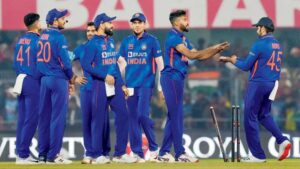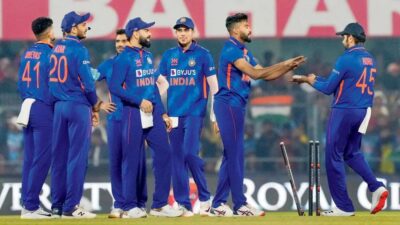
The focus may finally be back on the 50-over format, but the numbers suggest that the “middle child” is increasingly an afterthought for both India and modern-day cricket.
How desperate is India to win the World Cup on home soil later this year? This June, it will be a decade since MS Dhoni lifted the Champions Trophy at Edgbaston, the last ICC trophy that India won. You have to go back another two years for the last World Cup win. But whereas the buildup to that 2011 World Cup bordered on the obsessive, it’s hard to detect similar fervour a dozen years on. Truth be told, a significant number of fans would be thrilled if India won the World Test Championship in June, against Australia at The Oval. The 50-over World Cup is no longer the only trophy worth coveting.
That sentence will seem like sacrilege if you came of age in the 1980s. Because of what Kapil Dev’s unfancied team did over the course of 17 days in June 1983, the 50-over game and the trophy handed out every four years became the ultimate goal if you were a player. Sachin Tendulkar could have retired after the 2007 World Cup debacle in the Caribbean, with his place in the game’s annals more than secure. But the desire to emulate the heroes of his youth kept him going, all the way to an unforgettable World Cup final on his home ground in Mumbai, and beyond.
Rahul Dravid, Sourav Ganguly, Anil Kumble and VVS Laxman all retired as bonafide legends of the game. The first three played in a World Cup final, a crushing defeat to Australia in 2003, but unlike Tendulkar, their 50-over journeys didn’t extend as far as that night of redemption in Mumbai. As for Laxman, he never even played a World Cup game. Each will tell you how much that winner’s medal would have meant.
This, though, is a very different time. For the generation that has grown up in the 2010s, ODI cricket is almost the middle child, the afterthought. An aging generation still prizes Test cricket, especially in an era where techniques from the other formats have added to the players’ skill sets, allowing teams like England to Bazball along at six runs an over or more against the red ball.
Twenty20 cricket is the format of choice for the vast majority of fans. Not only do they follow a handful of competitive leagues around the world, but there’s also a biennial T20 World Cup to focus on. For Indian fans, who haven’t tasted glory since the inaugural edition in 2007, the wait has become somewhat similar to the generational angst that accompanied the quest for World Cup success post-1983.
As far as cricket history goes, a dozen years is not that long a passage of time. But raw numbers amply illustrate just how Indian cricket’s priorities have changed. Between crashing out of the World Cup in the first round in 2007 and the start of the 2011 competition, India played 118 ODIs, compiling a 69-42 win-loss record. MS Dhoni played a whopping 105 of them, while eight other players including Tendulkar (60) won more than 50 ODI caps in that period. Another ten – including Virat Kohli (45), Ashish Nehra (45) and Munaf Patel (34), key members of the World Cup squad – played at least 30 times.
Since the heartbreaking loss to New Zealand in the 2019 World Cup semifinal, India have played just 51 ODIs, winning 31 and losing 17. Only two men, Shreyas Iyer (36) and Kohli (35), guaranteed to be in the World Cup squad have made more than 30 appearances. Including two home series against Australia (there’s another in September), an away assignment in West Indies and the Asia Cup, wherever that’s eventually held, India will play at most another 14 ODIs before the World Cup. It’s almost certain that not one player will cross 50 caps in the period between World Cups.
In the same period, India have played an astonishing 84 T20Is, including World Cups in 2021 and 2022. It’s a measure of how much India have rotated the squad that no player has more appearances than Rohit Sharma (54). This kind of variation between squads can be seen in two ways. In one sense, it’s representative of the far greater depth at Indian cricket’s disposal. Secondly, it’s also recognition of the role that burnout plays in elite careers.
Many will say that they didn’t see the best of Dhoni after he lifted the 2011 World Cup trophy. How could they have? In between the 2007 and 2011 competitions, in addition to the 105 ODIs, Dhoni also played 39 Tests and 25 T20Is. There was also the small matter of the first three seasons of the Indian Premier League, with his Chennai Super Kings reaching the playoffs on every occasion (43 games for Dhoni), and the Champions League T20 in 2010, when he played six matches as Chennai won the title.
A lesser man than Dhoni would have buckled under such a load. It’s testament to his strength of will and character that he then led the Test side through a painful transition, won the Champions Trophy (2013) and reached another T20 World Cup final (2014) before handing over the reins.
For Rohit and his likely compatriots in a 15-man World Cup squad though, the time for rotation and rest is over. The six matches against Australia, as well as the Asia Cup against teams likely to do well on Indian pitches, are crucial preparation for the big event. We can count out Rishabh Pant, while it remains to be seen whether Jasprit Bumrah will be anywhere near the match fitness required to get through a competition as arduous as the World Cup.
Indian cricket has to prepare as though both men will be absent. Instead of Bumrah’s probing yorkers and splice-jarring bouncers, India need to fine-tune a Plan B, regardless of whether it’s built around Mohammed Siraj, Umran Malik or someone else. They also have to decide who the frontline spinner is. Since the last World Cup, Yuzvendra Chahal averages 29, Kuldeep Yadav 36 and Ravindra Jadeja 57. There really isn’t a standout to compare to Kumble in 1996, or Harbhajan Singh and R Ashwin in 2011.
Just as Ashwin used his IPL and Champions League performances to force his way into the 2011 World Cup squad, the feeling persists that there will be room for a surprise spin bowler, or even two, to make the 2023 squad. And just as Yuvraj Singh’s all-round ability balanced the 2011 side, so India will need a fully fit Hardik Pandya to chip in with both bat and ball.
For much of the past four years, the focus has either been on the red ball or on T20 World Cups. Now, with just over six months to go before the first ball is bowled, the spotlight moves back to a tournament that defined Indian cricket for over a generation. It may not mean as much as it once did, but Rohit – agonisingly dropped from the squad after 61 games between 2007 and 2011 – would be the first to tell you that it still means an awful lot.




